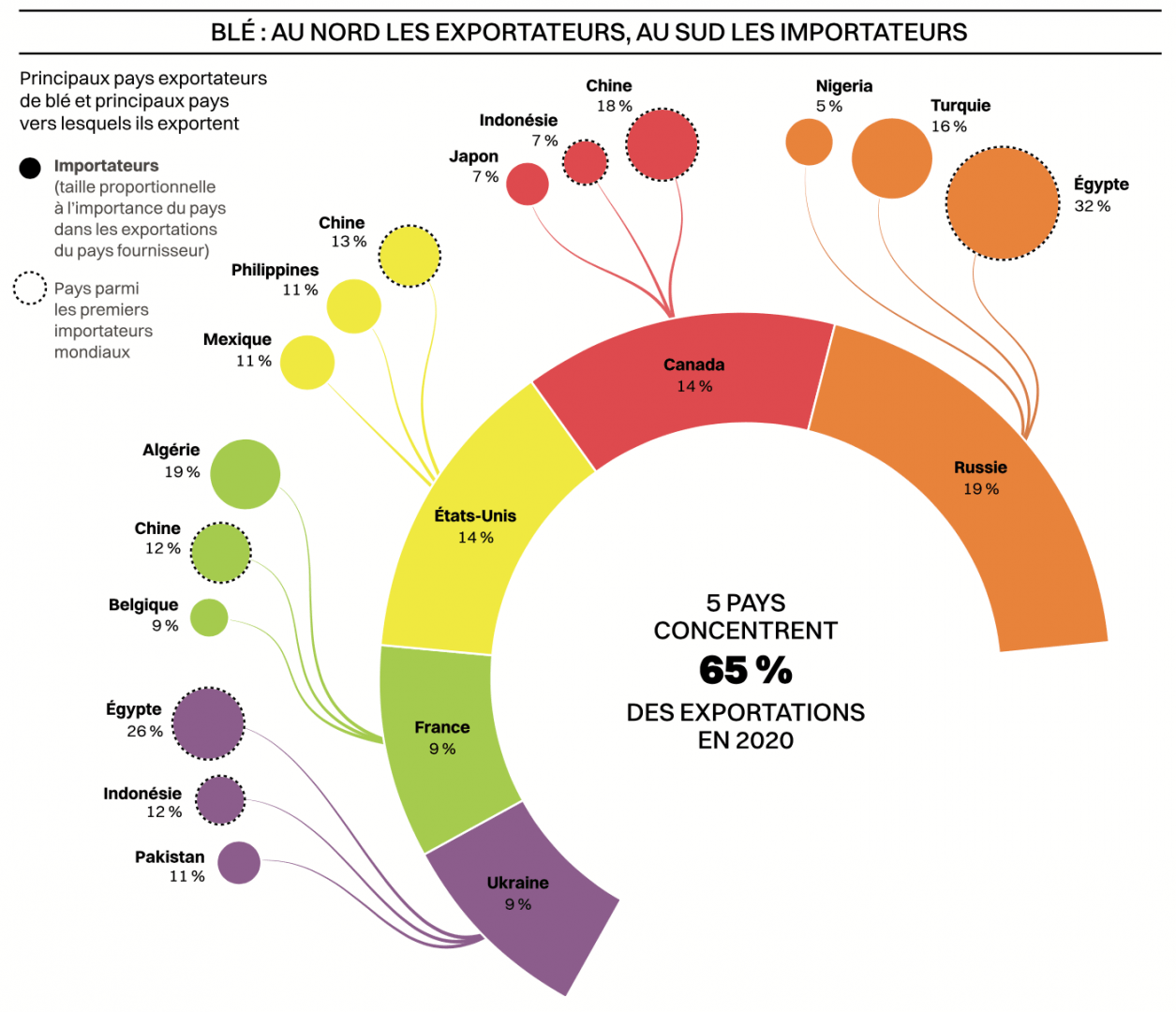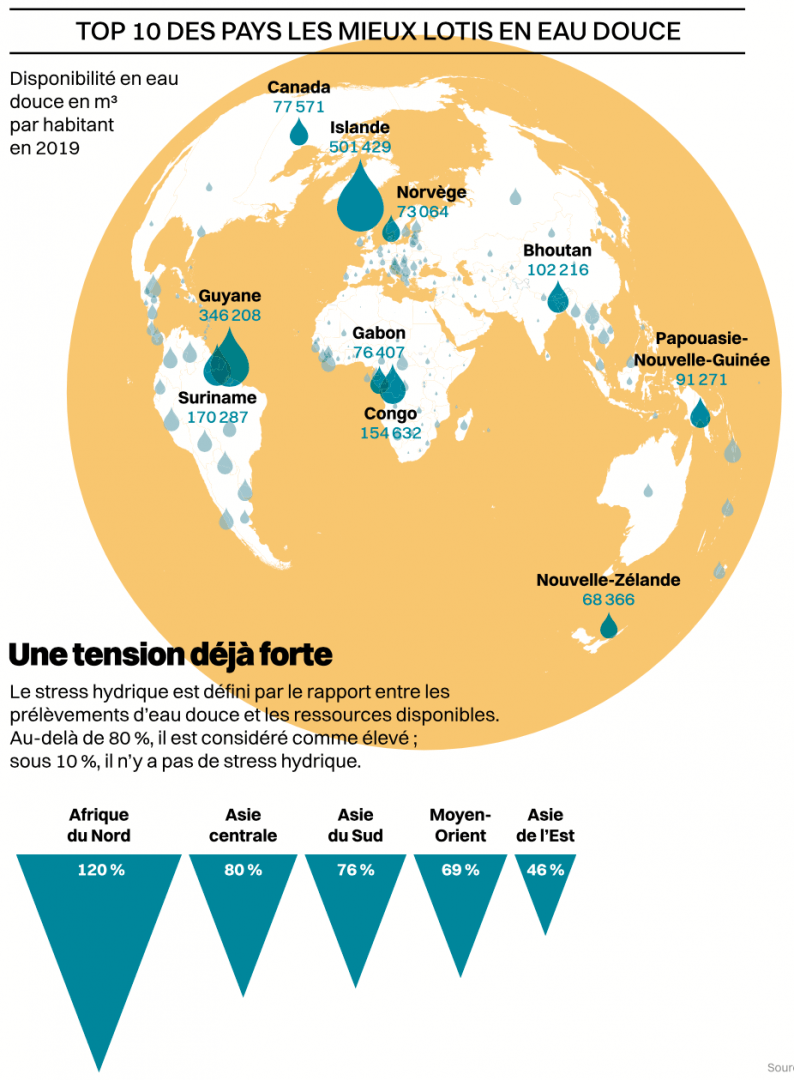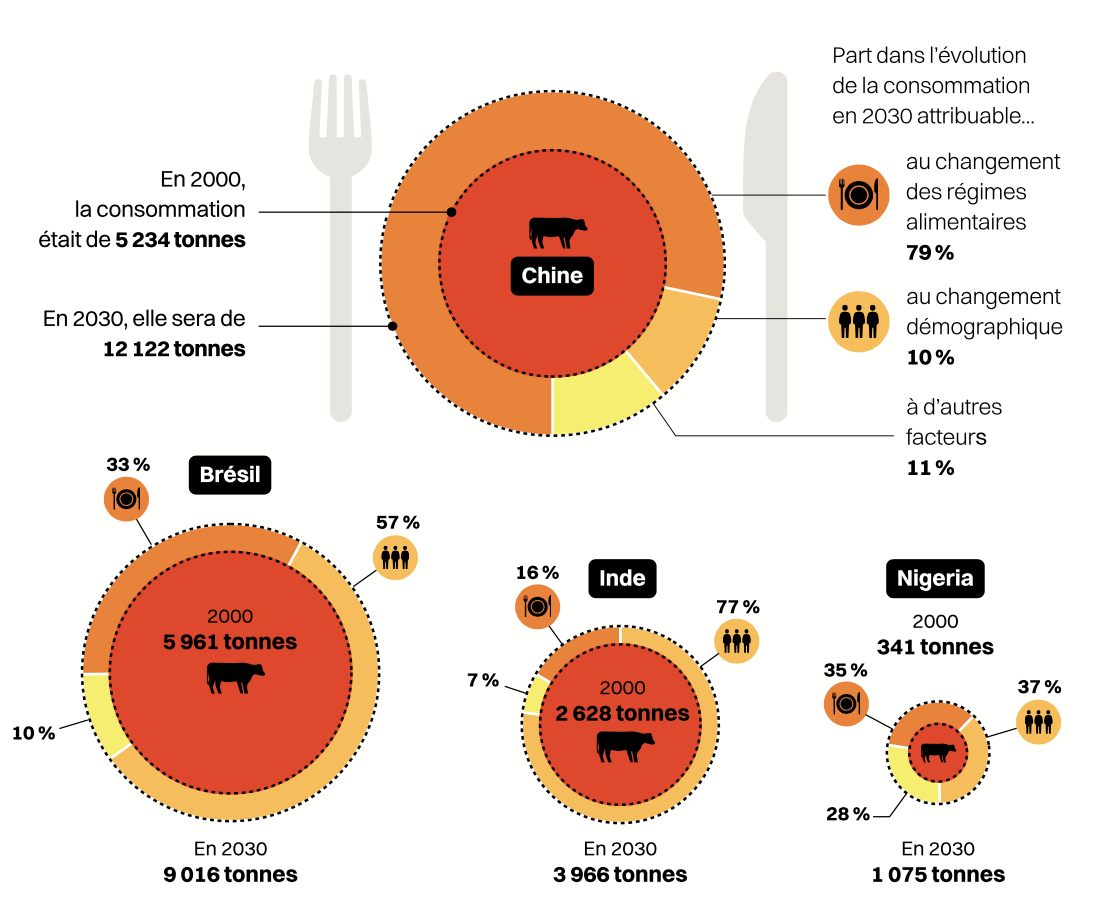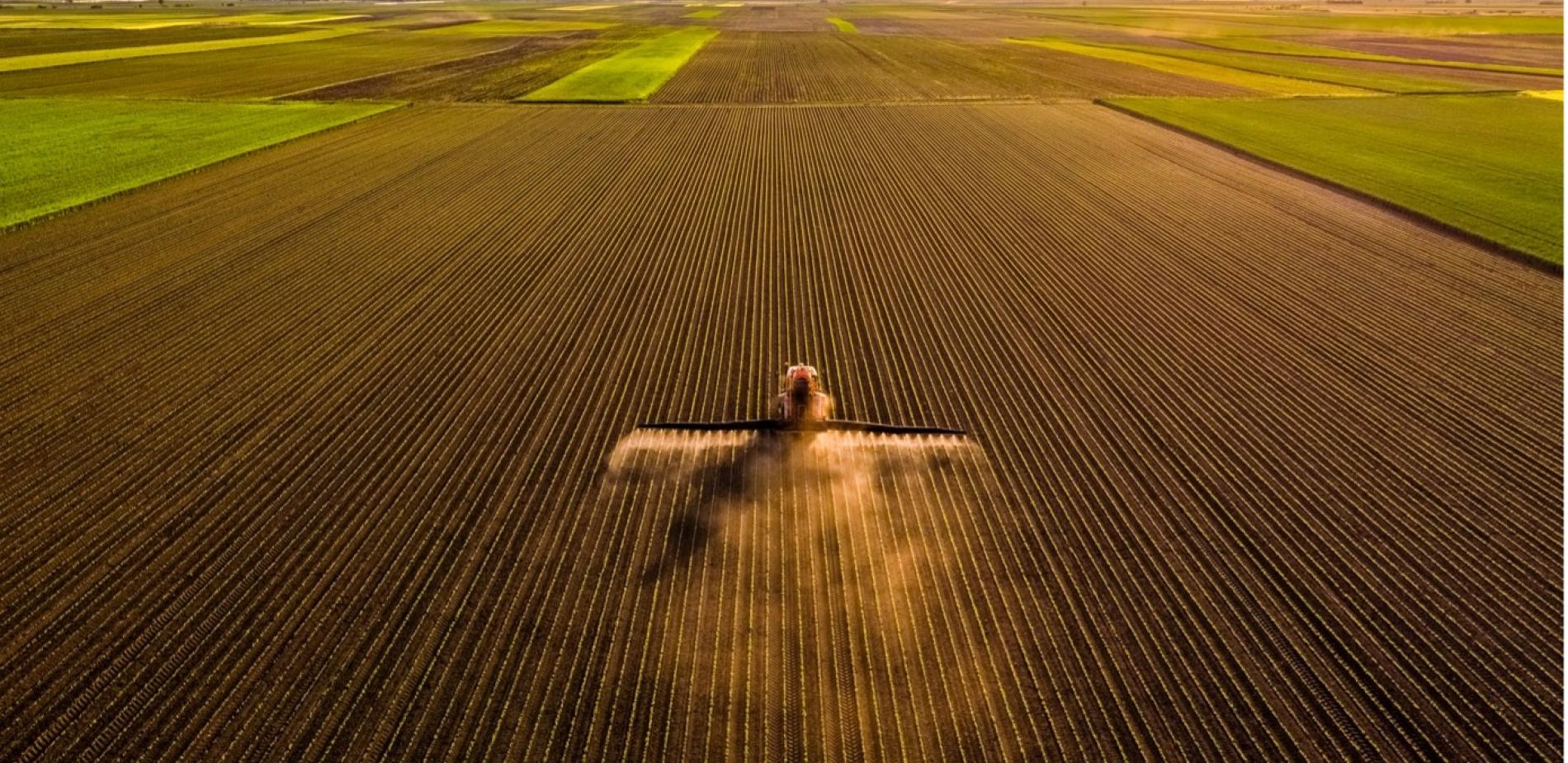
Too many mouths to feed?
Will the Earth be able to feed 10 billion people? The answer is yes, provided we produce better, consume better and distribute resources better.
by Barbara Vignaux - Published on
A recurring concern
The spectre of widespread famine resurfaces periodically, now aggravated by climate change. A concern that needs to be nuanced.
The world’s population is expected to peak at over 10 billion in 2080. A major issue is food. Will the Earth be able to feed so many human beings? The question resurfaces periodically, each time the threshold is crossed: 6, 7, 8 billion. . . The answer, which is deceptively obvious, would be to control population growth in order to control resources. The idea is not new, since it was formulated in 1798 by the British economist Thomas Malthus (1766–1834) in his book An Essay on the Principle of Population. In concrete terms, the world population has increased eightfold between 1800 and today. In the period 1999–2022 alone, i.e. less than 25 years, it has increased by 2 billion. Yet despite this growth, starvation has been declining for several decades: natural resources are therefore sufficient to feed a growing world population. In the future, the question is not so much whether the Earth will be able to feed 10 billion people, but how: as the fight against climate change imposes new constraints, food needs to become more “eco-friendly”. On the supply side, farming practices must become greener. On the demand side, eating habits must be adjusted to planetary capacities, with reduced meat consumption and a fierce fight against waste. Finally, access to food must be better distributed: famine is still rife today. Using these parameters, researchers have developed various scenarios, from the most disturbing to the most virtuous.
Malthus, a controversial posterity
What is Malthus’ legacy? Putting forward the idea, original at the time, that the food available should define the size of the population, this Anglican clergyman advocated chastity and late marriage to limit the number of poor people in London society at the time. However, in the 1960s, the Danish economist Ester Boserup (1910-99), sometimes described as “anti-Malthus”, showed that, on the contrary, demographic pressure favoured the development of agricultural techniques and thus production. Today, coercive birth control is no longer on the agenda: demographic ageing is what is mobilising the public authorities . . . and thus a revived birth rate.

The persistence of famine
Aggravated by conflicts and crises, the inequitable distribution of resources remains at the root of famine throughout the world.
In 2022, global food production and trade will theoretically be able to feed the world's 8 billion people. However, according to the World Food Programme (WFP), almost one in ten people still do not have enough to eat. But the availability of natural resources is hardly in question. In September 2022, the WFP warned of the catastrophic situation of six countries and nearly one million people, under the combined effect of natural disasters, with a serious drought in the Horn of Africa, and armed conflicts, as in Somalia. "Violent conflict remains the main driver of acute starvation," said the WFP. But at the time, food insecurity affected more than 26 million people, who are still suffering from the medium-term effects of the health crisis (and the subsequent destruction of jobs) and the fallout from the war in Ukraine (and the rise in raw material prices). Set by the United Nations in 2015 as part of the Sustainable Development Goals, the "zero hunger" target for 2030 now seems out of reach: by that date, the UN points out, nearly 8% of the world's population will still be starving, "even in the event of a global economic recovery". Humanitarian aid therefore remains essential to ensure global subsistence, as it helps to offset unequal access to global food resources from time to time. Two figures echo this inequitable distribution in an ironic way: while nearly 830 million people are undernourished,3 nearly one billion are obese.
3 État de la sécurité alimentaire dans le monde, ONU, 2022
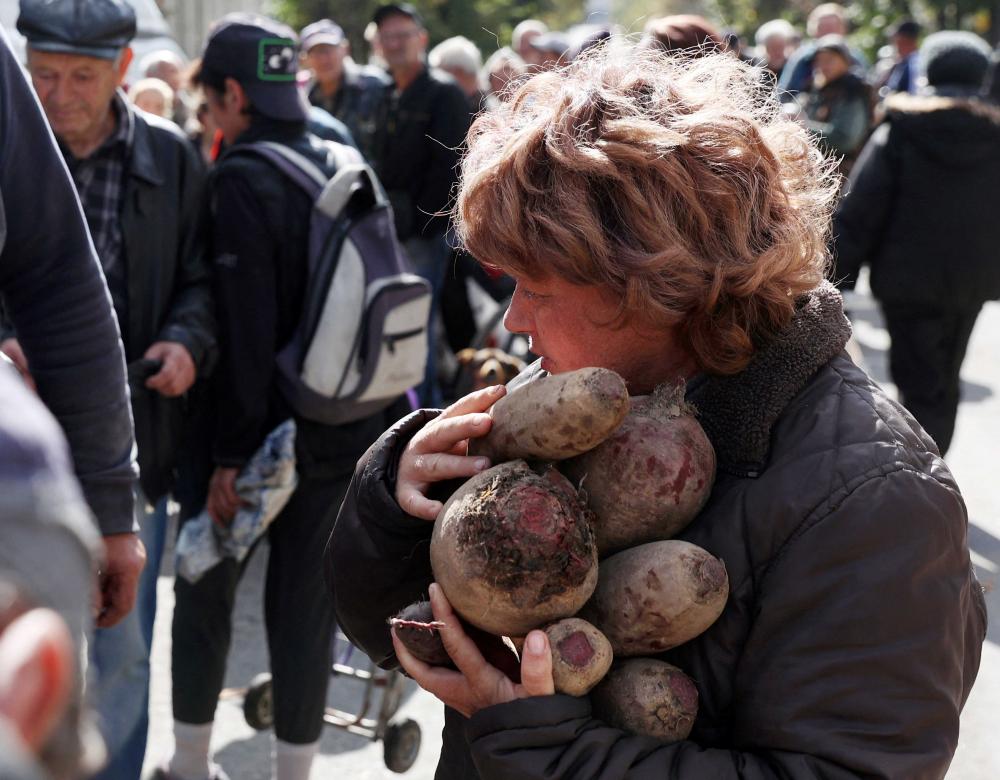
When the scenario is disrupted by an unforeseen turn of events
Two recent events remind us that food security remains subject to unpredictable risks that cannot be modelled in scenarios of the future. After the Covid-19 pandemic in 2020, which disrupted supply chains, Russia’s invasion of Ukraine led to a surge in the price of cereals and fertilisers, especially nitrogen (largely extracted from gas). The reason: the “bread basket” of Ukraine and its neighbour, Russia, are among the world’s leading grain exporters. As the largest importer of wheat, Egypt has had to build up strategic stocks as a matter of urgency and diversify its suppliers.
Between climate and trade, agriculture is under stress


Healthy eating for the world
Is there a menu that can feed a growing world population without further damaging the environment?
Forecasters have long focused on how to produce more food, but in the last decade or so they have also recommended consuming . . . much less. The main guidelines for a diet that is both good for human and environmental health have now been identified: reducing daily calorie intake by about a third (including waste and spoilage) and eating fewer animal products. Bringing together 40 experts in nutrition, public health and the environment, an international panel convened by the medical journal The Lancet has defined a global “healthy diet” for 2050. 4 On the menu: doubling the world’s consumption of fruit, vegetables, nuts and legumes, and halving the consumption of red meat and sugar. In this model, the populations of developed countries will have to make the most effort, since they currently eat the most meat and sugar. In addition, these countries will have to cut food waste . . . in half! The same experts estimate that this “healthy diet” would prevent some 11 million premature deaths per year caused by the overconsumption of food. This “healthy” scenario—which assumes that agricultural land is maintained at its current level, without expansion—is not necessarily the answer to the challenge of a virtuous diet. But it does show that technical solutions really do exist.
4 The Lancet, 2 février 2019
Regionalised food production?
What if the solution were an agricultural supply on the scale of large regions (Europe; North America, etc.)? This is one of the scenarios for 2050 drawn up by two French organisations, CIRAD (Agricultural Research Centre for International Development) and INRAE (National Research Institute for Agriculture, Food and Environment), entitled Agrimonde-Terra (published in July 2020 in Plos One). This scenario has multiple advantages: linking the food industry and regional production by favouring varieties adapted to the local climate; shortening supply chains by limiting the risks of disruption, and reducing storage and global trade. The Near and Middle East, North Africa and West Africa would, however, remain net food importers.
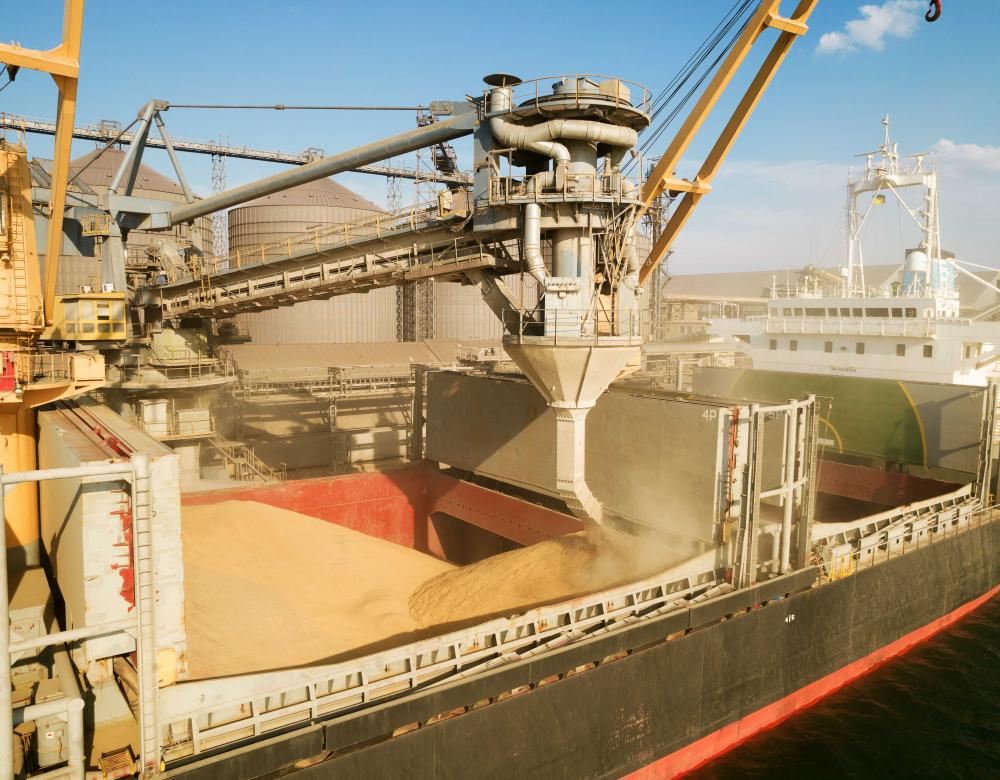

Loss and waste
Around the world, almost a third of the food produced for humans is lost or wasted. For example, 14% of the world’s crops are lost during production or transport, destroyed by frost or drought, a broken cold chain, etc. In addition, 17% of food is wasted, i.e. thrown away by retailers or consumers. Loss is more common in developing countries, before food reaches the consumer; waste occurs more commonly in rich countries once it has been put on sale. In addition, this third of lost and wasted food contributes to 8–10% of global greenhouse gas emissions, according to the UN Food and Agriculture Organisation (FAO).
Less meat on the menu
We are a long way from the panacea of eating no meat at all, but a reduction in global consumption is essential.
Excessive consumption of animal products above 25 or 30 grams/day—especially meat—is detrimental to human health, increasing the risk of hypertension, cardiovascular disease, type 2 diabetes and colorectal cancer. It also harms the environment, since livestock farming (cattle, sheep and goats) occupies two-thirds of the world’s agricultural land and generates more than 14% of greenhouse gas emissions. However, we should beware of false solutions such as veganism, which are often considered from the point of view of the North. The proportion of intensive and polluting industrial livestock farming must undoubtedly be reduced. But in the South, livestock farming also ensures the subsistence of 1.7 billion smallholders8 to whom it provides wool, hides, food, traction power and fertiliser for the soil. In addition, 80% of livestock production is based on non-cultivable land like grasslands, mountains, steppes or savannahs, which are also reservoirs of biodiversity and store carbon. 9 Therefore world consumption should be oriented towards a better balance in the choice of protein, at the expense of animal and in favour of vegetable protein: the WHO and the FAO advocate a 50/50 ratio. This rebalancing would benefit legumes: lentils, beans, chickpeas and peas, which contain high levels of protein (20% to 40% depending on the species). Inexpensive and rich in fibre, legumes are also capable of fixing nitrogen from the air and therefore save on fertiliser.
How can we reduce the proportion of meat we eat?
La hausse de la consommation mondiale de viande est due à la croissance démographique et à l’évolution des régimes alimentaires, dans des proportions variables selon les pays.
L’exemple de la viande de bœuf
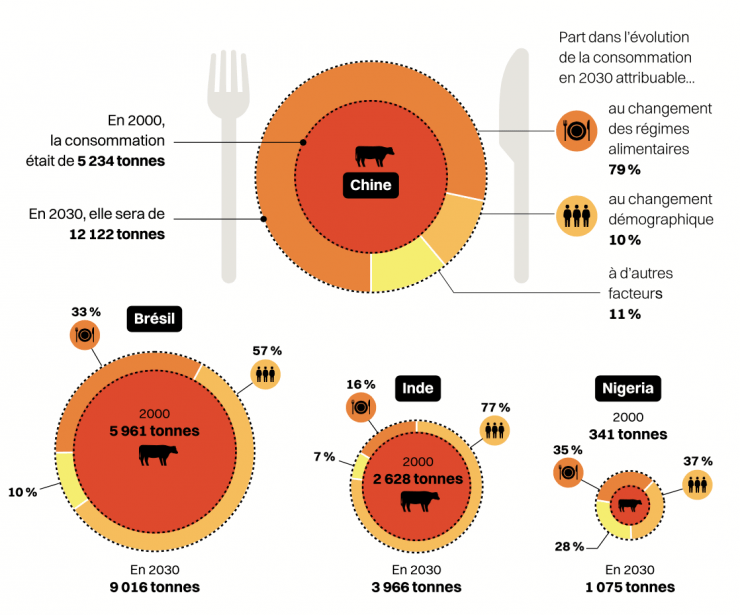
Greener production
It is already possible to produce more with fewer greenhouse gas emissions, using fewer chemical inputs.
In the future, more food will have to be produced to feed the world’s population, with an increase of 50% +70% by 2050 (compared with 2010), depending on the scenario. 5 However, it must involve sustainable agricultural practices, because the agri-food system currently generates more than 30% of greenhouse gases, is the main source of biodiversity loss and deforestation, and consumes 70% of the world’s fresh water. So how can we produce more and better? All the scenarios stress the need to improve agricultural practices. For example, the Potsdam Climate Institute estimates that the current system can only feed 3.4 billion people ecologically, but that it could feed more than 10 billion6 through proven measures such as expanding farmland; increasing irrigation, with water storage in the wet season and the use of drip irrigation; adding nitrogen to fertilise the land; restoring degraded land and mulching the soil to avoid unproductive evaporation. There are additional constraints, however, such as clearing new land or allocating water for irrigation. However, to improve agricultural productivity, there is still room for manoeuvre. The introduction of legumes, for example, improves resistance to diseases and pests and enhances soil fertility. The result: a 20% increase in yields of the main crops—rice, wheat and maize—worldwide and 40% in Africa! This is the result of an analysis of 450 field experiments conducted in 53 countries. 7
5 European Review of Agricultural Economics, September 2017
6 Nature Sustainability, 20 January 2020
7 Nature Communications, 22 August 2022
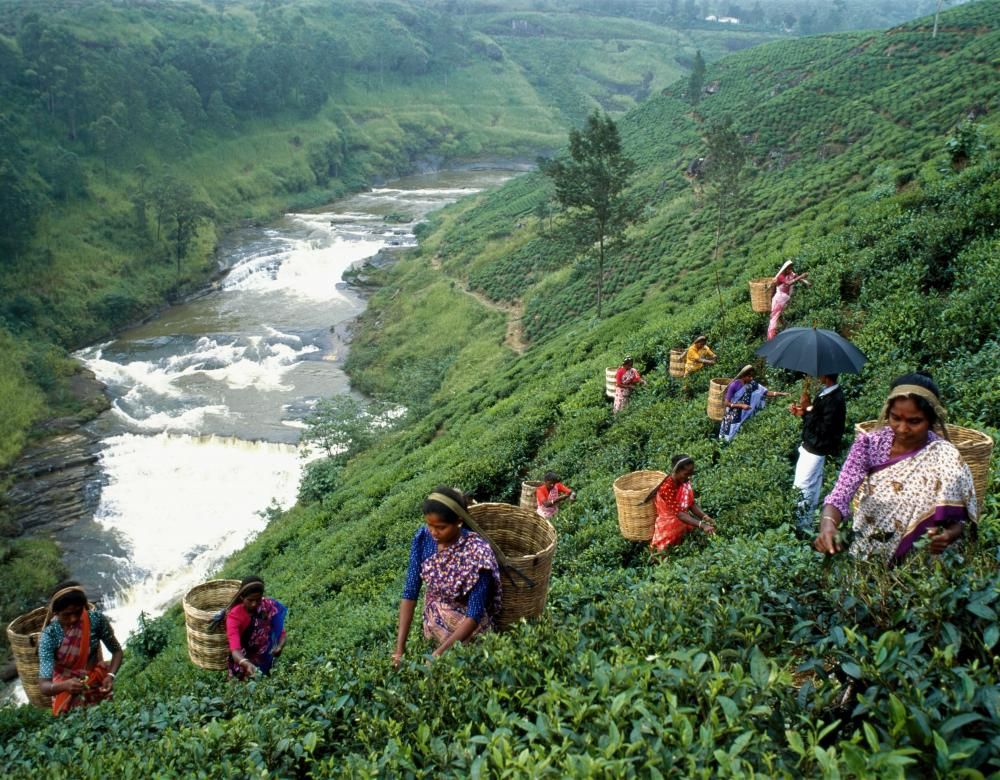
Organic farming everywhere in the future?
According to a Swiss team (Nature Communications, 14 November 2017), "100% organic" agriculture would be able to feed 9 billion people by 2050, but the feasibility and benefits remain controversial. On the one hand, the lower yields of organic farming would force the cultivation of new areas, including existing carbon-rich pastures or meadows (Nature Communications, 22 October 2019). On the other hand, a turnaround of this kind needs to be carefully prepared, as shown by the dramatic drop in production in Sri Lanka after the ban on chemical fertilisers and pesticides. The ban was imposed in April 2021 and lifted... six months later.
